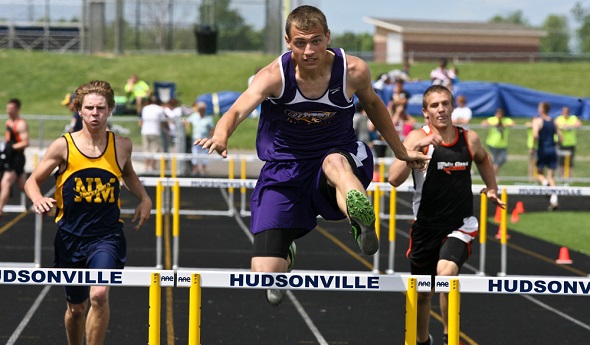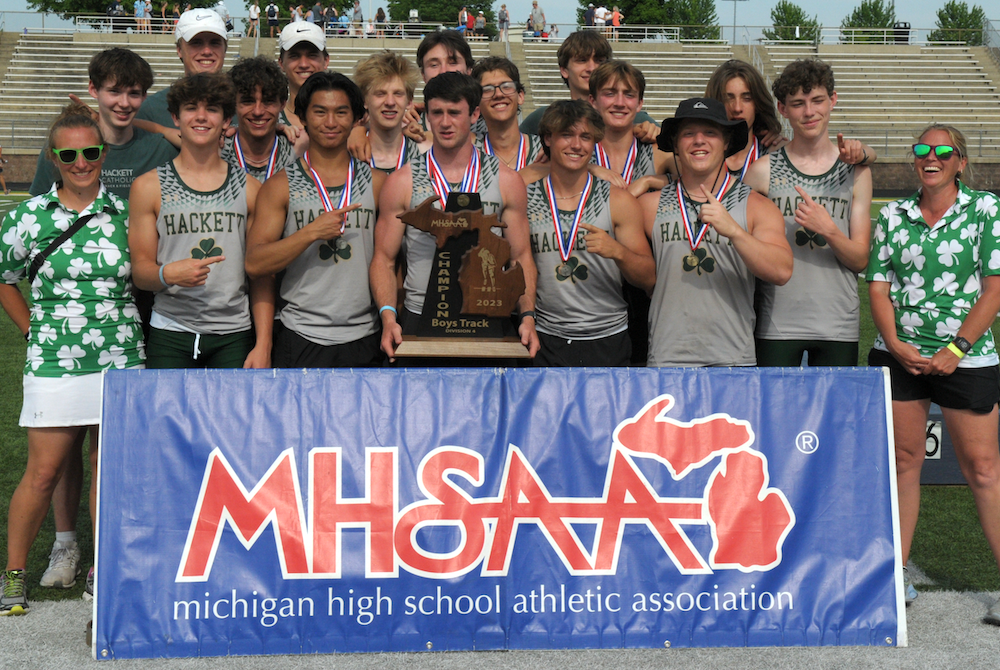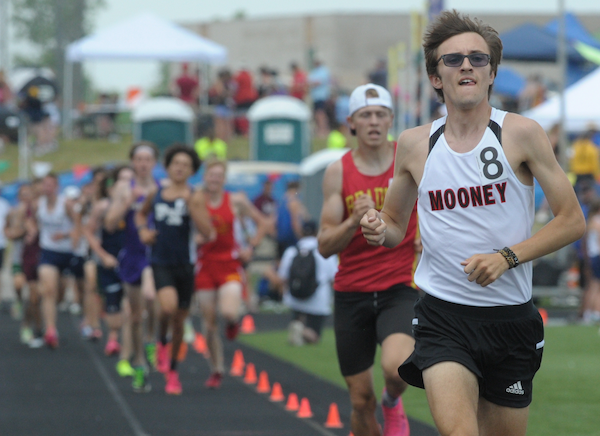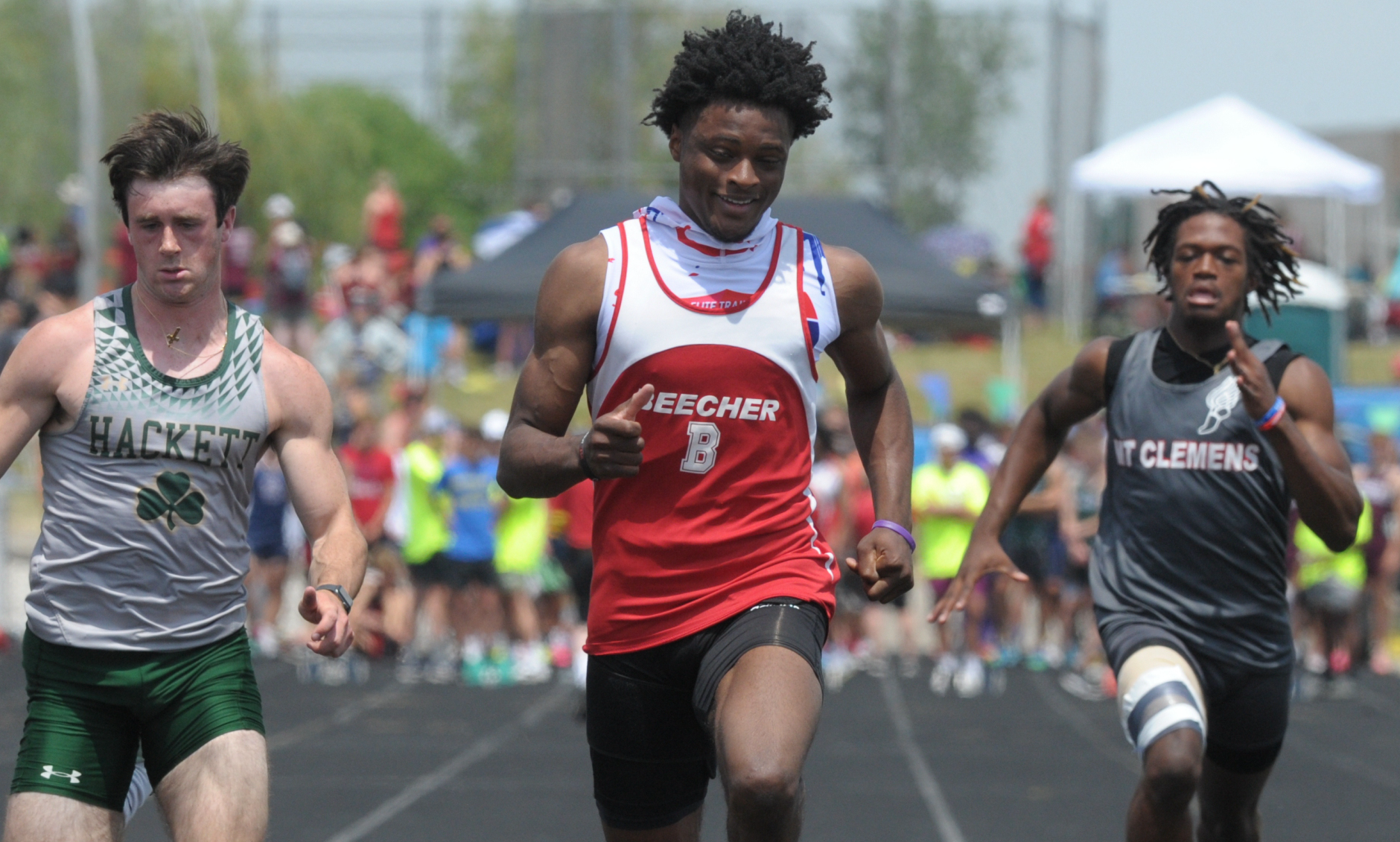
'Mr. Clutch,' Saugatuck Make Memorable Finish
June 1, 2013
By Chip Mundy
Special to Second Half
HUDSONVILLE – On the eve of the MHSAA Lower Peninsula Division 4 track and field event at Baldwin Street Middle School in Hudsonville, Saugatuck High School senior Bobby Drew was momentarily a forgotten young man.
Drew was still in the rest room when the team bus left for dinner without him Friday night, and a coach from another team discovered Drew alone and drove him the 20-some miles to join his teammates.
A Saugatuck coach was en route back to get Drew when a call was made that Drew was headed for the restaurant.
“I still got dinner, so we were cool,” Drew said. “It evened out. I got lasagna, and it was good.”
On Saturday, Drew was good, too, as were the rest of his teammates as Saugatuck won its first MHSAA team title with 58 points to outdistance runner-up Albion by 11.
“This is so unexpected,” Saugatuck coach Rick Bauer said. “We thought we would win a cross country title before we ever won a track title.
“Honestly, we came in with high seeds in a bunch of different events, and we said if we score as high as our seeds, we’d score 50 points and have a chance to win it. We scored 58 points. We scored higher than our seeds.”
One of those who scored higher than his seed was Drew, who plans to attend Wayne State University in the fall and play football. Drew was seeded second in the shot put and won it with a toss of 52 feet, 7 ½ inches, and he took second in the discus after being seeded third.
“I never expected to do this in track,” he said. “When I was younger, back then I was always thinking I was going to do good but not this good. It’s just amazing to me.”
Perhaps the thing that amazes people about Drew is his ability to come up with a big throw on his final toss of an event.
“He was in fourth place, and on his last throw he throws 52 feet 7 and a half inches and wins,” Bauer said. “He goes from fourth to first and wins, and that’s the beauty of this sport; the swings that can happen.”
Drew just smiled when asked about his ability to come through on his final throws.
“People call me Mr. Clutch because of how I do on my last throw,” he said. “It’s just the nerves. I get nervous and pop it out there.”
Saugatuck also got a big performance from senior Sean Kelly, who repeated as champion in the 3,200 in 9:35.99 and ran the second leg on the Indians’ winning 3,200 relay team which also included senior Zach Kerr, sophomore Joe Brown and freshman Alex Anschutz. Kelly also was runner-up in the 1,600, which left him a bit less than satisfied.
“I got second in the mile, so that’s the one area that didn’t go the way I wanted,” he said, “but we won the team, so it went as good as expected.
“It definitely was a surprise that we’re as good as we are this year. … It all came together.”
Kelly came from behind to win the grueling 3,200.
“I went out a little slower than I wanted in the first mile, but then I just pushed the second half and made sure the leader didn’t get away from me,” he said. “On the last lap, I just gave it everything I had left, and it ended up being enough.”
Saugatuck also had Kerr finish third in the 800, and he ran the anchor leg for the Indians as they took third in the 1,600 relay.
“A lot of guys put in four years of work,” Bauer said. “Zach Kerr, Sean Kelly, they have put in summer, winter, spring and fall for four years, and this is how they deserve to go out.”
It was a bittersweet day for runner-up Albion, which won the team championship last year and shared it in 2011. The high school in Albion is closing after this school year, so this was the last track meet for the program.
The school closing is the bitter, but the sweet was the two MHSAA championships won by the Wildcats. Junior Nolen Bright-Mitchell, who said he will attend Marshall High School next season, won the 200 a year after winning the 400. Bright-Mitchell won in 22.44 seconds and also ran the anchor leg for Albion on its winning 800 relay team that included junior Jamil Short, senior Terrance Byrd and senior Bryan Peoples.
The Wildcats also placed second in the 1,600 relay – the final event of the meet and the final track event for Albion until a time when the high school might reopen.
The only other double winner was senior Alexander Lodes of Climax-Scotts. Lodes repeated as champion in the 100 in 11.32 seconds as he barely edged New Lothrop junior Amari Coleman, who finished in 11.34. Lodes also ran the first leg for Climax-Scotts as it edged Bright-Mitchell and Albion in the 400 relay.
Litchfield senior Jacob Patrick repeated as champion in the discus with a toss of 187-2 – nearly 35 feet better than the effort of the runner-up Drew. Patrick holds the LP Division 4 meet record of 190-0, which he set last year.
Evart, which finished third, had a champion in junior Max Hodges, who won the 800.
Other individual champions were sophomore Dametrius Nelson of Genesee in the long jump, junior Luke Meyer of Addison in the high jump, junior Gavin Towery of Homer in the pole vault, senior Andy Hauser of Pittsford in the 110 hurdles, senior Nick Vander Kooi of Fremont Providence Christian in the 1,600, senior Zack McGowen of White Cloud in the 400 and junior Clayton Meldrum of Kalamazoo Christian in the 300 hurdles.
Meyer, the state champion in the high jump, has agreed to play basketball at Central Michigan University after he graduates from Addison.
The other relay winner was White Cloud, which won the 1,600 relay.
PHOTO: Kalamazoo Christian's Clayton Meldrum clears a hurdle Saturday; he won the 300 and finished fifth in the 110 race. (Photo by Carter Sherline. Click to see more photo coverage from RunMichigan.com.)

Thrower Claims Lone Individual Title to Lead Hackett to Team 3-Peat
By
Tom Lang
Special for MHSAA.com
June 3, 2023
Kalamazoo Hackett Catholic Prep just keeps winning and winning.
This time the Irish took home their fourth title in the last five Lower Peninsula Division 4 Track & Field Finals, on Saturday at Hudsonville.
Hackett’s only individual title was taken by discus winner Nathan Buchmann, a senior, who was fine knowing he was the shortest in stature among all the sizable competitors.
“In the offseason after football I worked out every day, working towards this goal,” he said after getting his medal. “I would say this takes 80 percent technique and 20 percent strength to throw the discus. So, length can help but if you have good technique and are really strong, that will play into it.
“I think we are very balanced throughout the meet today,” he said about teammates that scored points in finishes other than first place. “We have 13 guys here today, and we have people in a lot of the races. But I do not run; I have too short of legs to be a fast runner,” he said with a chuckle.
Buchmann had to work through a hip injury to compete this spring.
“I think the setbacks are what make you strong,” he said. “You can either give up through the setbacks or push forward and become better.”
 Coach Charissa Dean agreed.
Coach Charissa Dean agreed.
“The kids have big hearts,” she said after all the points were totaled and the Irish were on top once again, with 53. “They worked hard. They had a lot of potential when we started the season. And we had a lot of drive to put in the work, and we are happy the results came out the way they did.”
Reading was runner-up at 47 points, followed by Wyoming Potter’s House Christian with 42, then Fowler and Flint Beecher each with 37 points.
Senior Lezawe “Moses” Osterink, of Potter’s House Christian, placed second in 1,600 but took the 3,200 title as defending champ of both. He dominated the latter by lapping the field with a final lap kick that resembled more of a superhero speedster.
“Nobody really took it out that hard at the start,” he said. “There was a freshman (Marek Butkiewicz of Hackett) that tried to get the pace going quick, but me and Dakota (Dykhuis of Montabella) just kind of sat back and gradually pulled him through.
“We took it gradually, and I was just relying that I could kick.”
Kick did he ever. The trio were neck and neck the majority of the race in a grouping ahead of the pack.
“With 400 to go I just tried to go all out,” Osterink said. “I had a lot more left than I thought and I was pleased with the win. Not really the time, but that doesn’t matter, especially this hot out.”
The overall meet was in the low 90s/high 80s heat and searing sun all day. So, race officials allowed the unique opportunity for coaches to spray the runners with water and give them water bottles.
“It was very weird because I’ve never taken water to drink while I’m running, so I didn’t know how that would feel,” Osterink said. “And they were spraying us and hitting us in the face. It was kind of fun.”
Junior Tyler Lenn of Marine City Cardinal Mooney defeated Osterink at his own game in the 1,600.
“I’m feeling great,” Lenn said after grabbing the medal. “I said to a newspaper after one of my races (during the season) I was right where I wanted to be. This has been a long rebuilding process for me since an injury back in the fall, and I set a pretty high goal the day the injury happened. I was telling myself I needed to fulfill what I said I would do at the beginning of last cross country season. And that is what I did today.”
Lenn suffered an ankle sprain from a misstep that turned worse because he kept running through the season on it.
“Coming back from that was pretty tough, but I wouldn’t have it any other way,” he said.  “Perseverance; I said from the beginning what I was going to do. I kept my eye on that target, and no matter the circumstances life threw at me, that I was going to make it happen and I am a man of my word.”
“Perseverance; I said from the beginning what I was going to do. I kept my eye on that target, and no matter the circumstances life threw at me, that I was going to make it happen and I am a man of my word.”
Jaylin Townsend, a senior from Flint Beecher, dominated the short races. He won the 100 dash (10.67) and 200 dash at 22 seconds flat. It was his third 100 win at a Finals.
“I put in a lot of work; I had to three-peat,” he said after the 100. “There’s a lot of great competition here, so I knew I had to come out and run my best.”
Concord in the 400 (43.72), Buckley in the 800 (1:30.76) and 1,600 (3:29.13) and Potter’s House in the 3,200 (8:14.18) were relay champs Saturday. Reading’s Tayshawn Bester won the 110 hurdles (15.13), and Athens’ Landen Bennett won the 300 (39.85). Caseville’s Nathan Feltner won the 400 (50.76), and Vestaburg’s Owen Patton claimed the 800 (1:55.11).
Fruitport Calvary Christian’s Bradley Richards won the high jump (6-10), and Peck’s Alex Affer won the long jump (23-4). McBain Northern Michigan Christian’s Isaac Bowden was first in pole vault (13-0), and Brown City’s Kyle Affer won shot put (49-2).
PHOTOS (Top) Kalamazoo Hackett Catholic Prep celebrates its third-straight LPD4 title Saturday. (Middle) Cardinal Mooney's Tyler Lenn, far right, sets the pace in the 1,600. (Below) Flint Beecher's Jaylin Townsend, middle, crosses the finish first for one of his two sprint championships. (Photos by Ken Swart/RunMichigan.com.)

